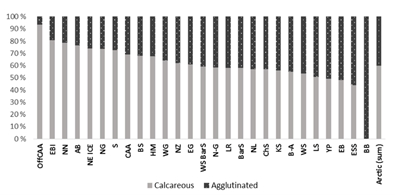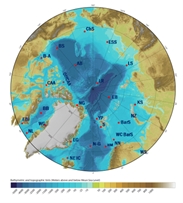|
|
R2 - Marine Biodiversity and Ecological Function
The goal of WP2 was to predict the effects of ocean acidification on the biodiversity and structure of benthic systems in Arctic seas. The relational database integrating archived APN data on benthic diversity with modelled (by WP3 team) information on carbonate saturation levels and other environmental data was built in Access. A total of 141 stations with information on benthic species abundances distributed from the Kara Sea, across the Barents Sea, north to Franz Josef Land, and extending west of Svalbard were included in the data set. All scientific names were checked and corrected according to the World Register of Marine Species (WoRMS, www.marinespecies.org). Over 13,000 species abundance records are found in the database. The environmental data (modelled values for the locations with existing biological information) included: bottom water temperature, salinity, DIC concentration, total alkalinity, ph and saturation states (calcite and aragonite) as well as primary productivity (integrated for euphotic zone), POC export (at 100 m) and pCO2.M2.1 was delayed until M16 and led directly into D2.1, a database from Barents Sea and neighbouring Arctic seas benthos (as described above), that has now been delivered to the public-access Pangaea data centre (in M35).
This has been approved and we await for final doi numbers for the metadata and data files. M2.2 was accomplished in conjunction with cruises aboard Oceania and Helmer Hanssen in Svalbard. These samples contributed to work conducted in WP3 as well as a publication contributing to M2.3, M2.4 and D2.2 in this WP, including Deja et al (2016). Deja et al. catalogues biodiversity and distributional patterns of echinoderms in Svalbard waters. More than 20,000 specimens and 467 samples of these calcifying organisms from archival and POL-NOR data collections predicted total species richness (38 spp) and identified the most abundant taxa. Ronowicz et al. (will be submitted in July 2017) investigated encrusting fauna on kelp holdfasts, many of which are calcifying, in relation to environmental and biotic characteristics. Mineral suspensions, which vary due to levels of glacial and riverine outflow, impacted hydrozoan species richness (not calcifers) whereas Bryozoa (calcifiers) were relatively insensitive to this parameter, expected to increase in a changing Arctic. This work also contributes to M2.3 and M2.4 as well as D2.2. Fifty-one studies of calcifying and non-calcifying benthic foraminifera conducted over the past 54 years were reviewed. Species diversity and biogeographical patterns were described, and six distinct bioregions were identified. Expansion of sub-Arcitc and boreal taxa was observed in the Atlantic bioregion. In Baffin Bay and the Eurasian shelf, observed replacement of calcifiers with non-calcifying taxa is likely related to dissolution and bottom waters with reduced pH. This manuscript by Jernas and Włodarska-Kowalczuk (will be submitted in July 2017) contributes to both D2.2 and D2.3.
 
|
|
|
Figure 1. Left - proportion of calcareous and agglutinated (organic walled included) species in different Arctic regions. Right - bathymetric map of the Arctic region with symbols indicating regions: Northe and East Iceland (NE ICE), North Greenland (NG), East Greenland Shelf (EG), West Greenland Shelf (WG), Norwegian-Greenland Sea (N-G), Northern Labrador (NL), Baffin Bay (BB), Eastern Baffin Island fjords (EBI), Offshore Canadian Arctic Archipelago (OffCAA), Arctic Canadian Archipelago (CAA), Beaufort – Amundsen (B-A), Beaufort Sea (BS), Chukchi Sea (ChS), East Siberina Sea (ESS), Laptev Sea (LS), Kara Sea (KS), Barents Sea (BarS), Western and Central Barents Sea (WC BarS), Svalbard fjords (S), Novaya Zemlya fjords (NZ), Northern Norway (NN), Amerasian Basin (AB), Lomonosov Ridge (LR), Eurasian Basin (EB).
|
The last major contribution of this WP fulfills D2.3 and also contributes to D2.2 (and M2.3-2.5). This manuscript investigates which taxa in the Barents Sea region may be vulnerable to combined changes in temperature and calcium carbonate saturation state (omega) over the next 50 y. We extracted faunal distributional data from the Ocean Biogeographic Information System (OBIS) database from around the entire Arctic for 90 key taxa in the Barents Sea. Then, working in close collaboration with WP4 and WP1, we used models to estimate temperature and omega at the time of collection, and thus produced ranges in these parameters where each species currently lives. The same models were then used to identify the mean values for these two variables from the period 2000-2019 and 2050-2069. In the figures below we see a small warming of the southern Barents Sea, but most striking is the shift toward a lower omega (from > 1.5 to between 1 and 1.5) in the Atlantic (southern, blues become greens)= region, and from the 1-1.5 omega values to undersaturated conditions (< 1) in the Arctic (northern part, green becomes red).
Of the 90 taxa investigated, 80 had more than 30 records for which we could estimate these two parameters. These taxa range across the most important phyla, include calcifying and non-calcifying taxa, and encompass abundance and biomass dominants. Surprisingly, there was no difference in predicted vulnerability in calcifiers vs. non-calcifiers, and the key calcifying phyla (Echinodermata and Mollusca) were less vulnerable than Arthropods (crustaceans) and polychaete worms (see table). Finally, Arctic taxa, generally described as being sensitive to climate change, were less vulnerable to changes in temperature and omega than their more boreal counterparts.
| #taxa | #vulnerable | %vulnerable |
| Bryozoa | 1 | 1 | 100 |
| Arthropoda (Crustacea) | 11 | 5 | 45 |
| Echinodermata | 17 | 6 | 35 |
| Mollusca | 25 | 6 | 24 |
| Annelida (Polychaeta) | 11 | 6 | 56 |
| Calcifier | 50 | 18 | 36 |
| Non-calcifier | 15 | 6 | 40 |
| Arctic | 17 | 2 | 12 |
| Arcto-boreal | 29 | 14 | 48 |
| Boreal | 19 | 9 | 47 |
These results are surprising, first in that more than half the taxa were not observed to be vulnerable, but also that Arctic taxa and organisms from the most important calcifying phyla and were least vulnerable. Some of the taxa with key functional roles in the Barents ecosystem, such as a dominant filter feeder on hard bottoms (Balanus balanus), and the ecosystem engineer species Spiochaetopterus typicus, were highly vulnerable. The commercially important northern shrimp (Pandalus borealis), and abundance/biomass dominant soft-bottom species Mendicula ferruginosa and Chaetozone setosa, were also vulnerable to projected changes in temperature and omega.
These results indicate ecologically and economically relevant changes in ecosystem structure may be expected in benthic communities of the Barents region. In addition, these results point to new areas of research that should be investigated for a better understanding of impacts climate change, and particularly changes in ocean carbonate-chemistry. Clearly, many other environmental and ecological factors will determine survival of organisms in a future Barents Sea, but these results hint at both unexpected and potentially significant impacts within the next 50 years.
|
|

